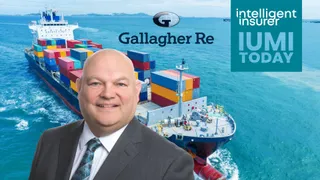
Renewables meet the sea, risk convergence is coming
When super typhoon Yagi swept across Hainan Island last year, it caused significant damage to both offshore and onshore wind farms, highlighting the delicate balance between renewable ambition and the realities of natural catastrophe risk.
Key points:
China drives APAC’s 2,000 GW renewables boom
Coastal build-up heightens nat cat risks
Due diligence on new tech is vital
Offshore wind farms are multiplying across China’s coastal waters and beyond, creating “key risks around accumulation in the South China Sea and off the east coast of China, and aggregation in coastal areas”, according to Robert McMillan, renewable energy practice leader at Gallagher Re.
“China presents a huge growth opportunity for energy reinsurance markets.” Robert McMillan, Gallagher Re
Talking to IUMI Today, McMillan described the scale of Asia-Pacific’s expansion: by 2028, the region is expected to have developed around 2,000 gigawatts of new renewable capacity, four times the planned growth in North America and more than double that of Europe.
“China presents a huge growth opportunity for energy reinsurance markets,” McMillan said, adding that the country was responsible for one third of all global ‘green’ investments. China’s renewable insurance market operates differently from those in more mature regions, with low deductibles, event caps and loss caps.
“The projects are strongly backed by governments,” McMillan observed, “and they’re looking for external investment from outside China.” But while European offshore wind farms often operate far from shore, “most of the products are in coastal areas” in China, raising exposure concentrations.
McMillan is concerned that larger turbines and new technologies might also “have an immaturity about them which could bring risk”.
Some risks are universal, however. “Cables and foundations are a common source of claims throughout the whole industry and it’s no different in China, Taiwan or Vietnam,” McMillan said.
Natural catastrophe exposure is also unavoidable. “We see lightning strikes that can affect offshore wind, onshore wind and solar. Those cause claims.”
Many of the claims are small and attritional, but severe events do occur. McMillan recalled that typhoon Yagi “demolished a few onshore wind turbines”, although he noted that resilience was vastly improving.
“There are lightning protection systems, we’re seeing better spacing for battery storage facilities and offshore wind now has protection systems to enable turbines to turn out of the wind.”
Wider market issues
The market’s response to rising nat cat risk has included portfolio diversification and proportional structures. “To mitigate nat cat claims is to take smaller proportional or quota shares. This seems to be the common thing,” McMillan stated.
Another trend is insuring multiple renewable types within one programme to spread risk across technologies and geographies.
Whatever the process, due diligence at the design stage is vital. Correct cable and lightning protection installation, as well as factoring in adequate battery spacing, are steps that “can be affected at the very start if you’re doing your due diligence”.
While Asia-Pacific’s renewables landscape has been “quite a soft market” in recent years, McMillan has seen stable pricing and evolving conditions. “In an immature environment, a lot of people use what they know, and that has come from Europe,” he explained.
“China has other priorities, so we’re seeing them look for a balance rather than follow what people have done previously in countries that perhaps have different risks.”
Marine and renewable energy insurance have traditionally been separate, but McMillan foresees increasing convergence. “Solar and onshore wind projects previously used to sit within property and engineering and construction project books, but they’re gradually being reconsidered,” he said.
Building multi-technology renewables teams therefore makes sense, given the similar engineering principles across solar, battery storage and wind. By 2030, McMillan expects stronger client relationships, better transparency in claims and losses and greater comfort in working with local offices. Nat cat will remain a priority and improved tools will be needed to reflect offshore wind realities and assess accumulation.
To prepare for tomorrow’s future, Gallagher Re is investing in data-driven insight. “We use a tool called TGS 4C which allows us to look at the structure of a wind farm, define what nat cat risks they have and give clients a good overview,” McMillan said.
Collaboration with established catastrophe modelling providers is central to this, ensuring shared understanding. Reflecting on his earlier work in Asia-Pacific’s oil and gas sector, McMillan called the renewables boom “a breath of fresh air” and concluded optimistically: “Go to China, and you’ll see electric vehicles everywhere. There is no smoke. They’ve really embraced this, and it’s very warming to see that growth.”
Did you get value from this story? Sign up to our free daily newsletters and get stories like this sent straight to your inbox.
Editor's picks
Editor's picks
More articles
Copyright © intelligentinsurer.com 2024 | Headless Content Management with Blaze

